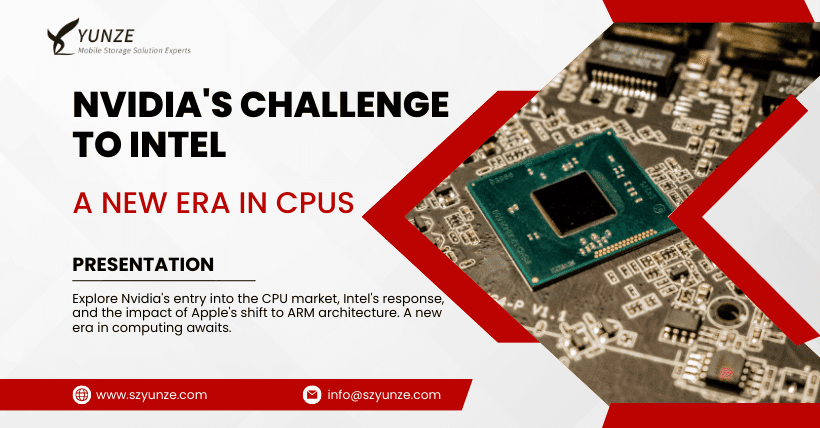1. Nvidia’s Entry into the CPU Realm
In the world of tech giants, Nvidia is making headlines by stepping into the CPU (Central Processing Unit) market. For years, Intel has been the dominant force in the PC market, with their x86 architecture-based chips. However, Nvidia’s recent announcement has sent ripples through the industry. Let’s dive into this development.
2. Chilly Times for Intel
Intel, the long-reigning king of the PC chip market, has been experiencing a series of setbacks. Factors like high inflation, slow hardware innovation, and geopolitical disruptions have hindered Intel’s growth. Even the demand for PCs saw a 20% year-on-year decrease in the third quarter of 2022, the most significant decline in three decades.
3. Pressure from Apple
Apple, a major player in the PC market, shifted from Intel’s x86 architecture to its ARM-based CPUs, resulting in improved performance and a significant surge in market share. This shift has not gone unnoticed by Microsoft, leading them to explore alternatives to Intel.
4. Microsoft’s Shift Towards ARM-Based CPUs
Microsoft is seeking to collaborate with Nvidia, AMD, and Qualcomm in developing ARM-based CPUs for PCs. Microsoft’s decision is influenced not only by Apple’s success but also by the rising interest in AI, especially with the advent of ChatGPT. Nvidia’s prowess in AI computing has made it an attractive partner for Microsoft.
5. Implications for the PC Market
This transition signals a potential seismic shift in the PC market. Intel’s monopoly may be challenged, paving the way for more diversified CPU options. The dominance of x86 architecture may give way to power-efficient ARM-based CPUs.
6. What Does This Mean for Consumers?
Consumers can anticipate more choices in the PC market, potentially leading to enhanced performance, lower power consumption, and competitive pricing. The shift to ARM architecture could mean better support for AI technologies and improved user experiences.
7. Intel’s Response to the Competition
Intel, aware of the emerging competition, is strategizing to stay relevant. Their recent financial report indicates a net profit, showing their determination to regain their footing. They project a moderate recovery in the second half of the year.
8. The Role of AI in this Transition
The role of AI in this transition cannot be understated. Nvidia’s significant influence in AI computing has driven this change. AI-powered applications, like ChatGPT, have created a demand for high-performance computing, and Nvidia aims to meet this demand with ARM-based CPUs.
9. Nvidia’s Dominance and Ambitions
Nvidia has been on the rise, commanding a substantial share of the GPU market. This foray into the CPU realm solidifies its position as a formidable competitor, not just against Intel but also AMD.
10. The Impact on PC Performance
ARM-based CPUs are known for their efficiency, making them suitable for PCs. This shift is expected to enhance overall PC performance and bring it in line with the requirements of modern applications.
11. A New Era for Personal Computing
The transition to ARM-based CPUs marks a significant shift in personal computing. It reflects the industry’s recognition of the need for more efficient, high-performance chips, which is crucial for the growing demands of AI and other applications.
12. Looking Ahead to 2025
The earliest release of ARM-based CPUs for PCs is expected in 2025. This development will reshape the landscape of the PC market, making it more competitive and dynamic.
13. Frequently Asked Questions (FAQs)
1. What are the key differences between CPUs and GPUs?
CPUs are designed for general computing tasks and excel in running applications and processing documents. GPUs, on the other hand, are optimized for parallel computing, making them ideal for handling large volumes of similar data simultaneously.
2. How has Apple’s transition to ARM-based CPUs impacted the PC market?
Apple’s move to ARM-based CPUs has led to improved performance and a significant increase in market share. This has prompted Microsoft to explore alternative CPU options.
3. What role does AI play in the shift towards ARM-based CPUs?
AI, with applications like ChatGPT, has created a demand for high-performance computing. Nvidia, a leader in AI computing, is venturing into ARM-based CPUs to meet this demand.
4. How is Intel responding to the competition in the PC chip market?
Intel is strategizing for a comeback, with recent financial reports showing a net profit. They anticipate a moderate recovery in the second half of the year.
5. When can consumers expect to see ARM-based CPUs for PCs?
The earliest release of ARM-based CPUs for PCs is expected in 2025, ushering in a new era for personal computing.
14. Conclusion
Nvidia’s entry into the CPU market, alongside the transition to ARM-based CPUs, heralds a new era in personal computing. This shift promises more choices for consumers, improved performance, and increased competition in the PC market. With AI at the forefront of this change, the future of PCs is poised for innovation and efficiency.

Related:
- Revolutionary 4nm RISC-V CPU: Surpassing AMD
- Reborn Arm PC: Revamped Performance Ahead
- 20 Handy Windows 11 Keyboard Shortcuts to Streamline Tasks



